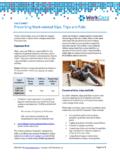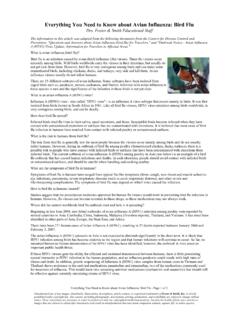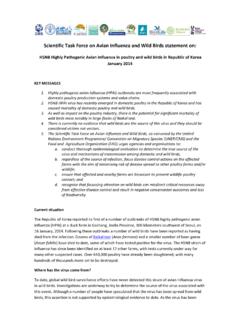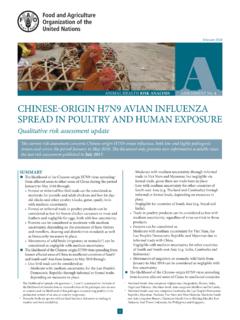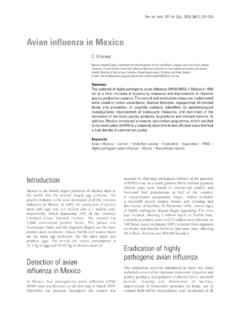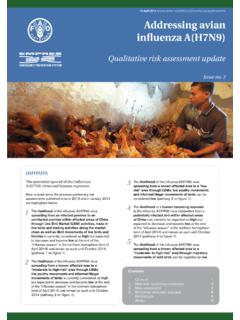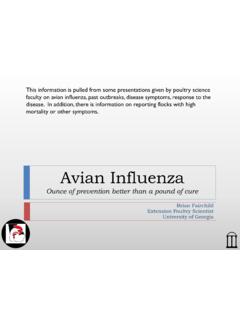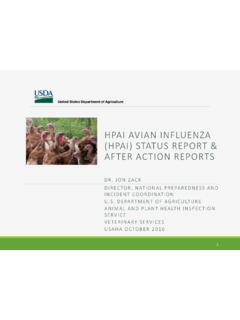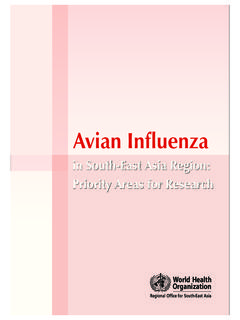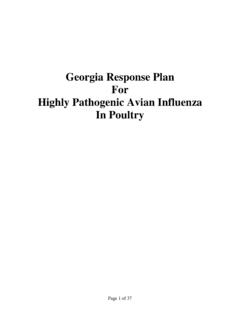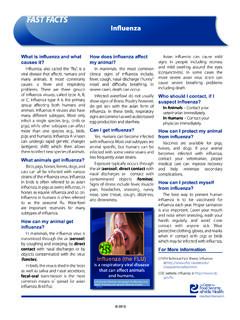Transcription of Avian Influenza A (H7N9): Exposure Risk and Prevention
1 FACT SHEET Avian Influenza A ( h7n9 ): Exposure Risk and Prevention (800) 455-6155 | | Copyright 2015 WorkCare, Inc. Page 1 of 3 Two Canadians who visited China were recently diagnosed with the first cases of Avian Influenza A ( h7n9 ) in North America. Flu can spread among people when a non-human (novel) Influenza A virus gains the ability for sustained human-to-human transmission. For example, flu viruses that circulate among birds are novel among humans; people have little or no immunity to them. No evidence of sustained person-to-person spread of h7n9 has been found and public health officials say this strain does not normally infect humans. However, in spring 2013, China began reporting h7n9 infections in people, most of them associated with coming into contact with infected poultry or contaminated environments such as poultry markets.
2 According to the Centre for Health Protection in Hong Kong, more than 500 cases of h7n9 flu were reported globally from March 2013 through January 2015, primarily in mainland China. Meanwhile, on Feb. 10, 2015, China s Center for Disease Control and Prevention (China CDC) reported 100 laboratory-confirmed cases of h7n9 and 25 related deaths since January alone. Cases were confirmed in the following administrative areas of China: Anhui, Beijing, Fujian, Guangdong, Guangxi, Guizhou, Hebei, Henan, Hunan, Jiangsu, Jiangxi, Jilin, Shandong, Shanghai, Xinjiang and Zhejiang. Smaller numbers of cases have been identified in Hong Kong, Taiwan and Malaysia. China CDC has advised residents of Guangdong and Fujian, where a large number of cases have been reported, to suspend the handling and exchange of poultry in affected regions.
3 As of Feb. 11, 2015, the Centers for Disease Control and Prevention ( CDC) had not issued any recommendations against travel to China. Business travelers are encouraged to contact WorkCare s TravelCare team for information on current conditions. Symptoms and Treatment If you have flu-like symptoms, are working in or have traveled to China within the past two weeks, consult with a medical professional, especially if you have a fever, cough or shortness of breath. Tell the provider about recent travel to China or suspected in-country Exposure . As with any illness, it s important to avoid contact with others while you may be contagious. Early symptoms of bird flu are consistent with seasonal flu and may include fever, cough, sore throat, muscle aches and fatigue, loss of appetite, and runny or stuffy nose.
4 Infection with the h7n9 virus often causes severe respiratory illness and requires hospitalization. FACT SHEET Avian Influenza A ( h7n9 ): Exposure Risk and Prevention (800) 455-6155 | | Copyright 2015 WorkCare, Inc. Page 2 of 3 The CDC and World Health Organization recommend antiviral treatment for all confirmed and probable cases of h7n9 . Antiviral treatment also is recommended for hospitalized patients (inpatients) and non-hospitalized patients (outpatients) who have had recent close contact with confirmed cases. This applies to health care personnel, family members, people who lived with or stayed overnight with an infected patient, and others who have had similar close physical contact. Antiviral treatment is not recommended for outpatients who only meet travel Exposure criteria: recent travel (within 10 days of illness onset) to areas where human cases of h7n9 have been reported or areas where h7n9 viruses are known to be circulating in animals.
5 Prevention There is no vaccine to prevent h7n9 flu. The following are recommended preventive steps for residents traveling to and working in China and other affected areas: Do not touch birds, pigs or otheranimals, dead or alive. Avoid live bird or poultry markets,farms with animals (wet markets) andanimal droppings. Eat poultry and other meat that is fullycooked (not pink) and served hot. Eat hard-cooked, not runny eggs. Don t eat food or consume beveragescontaining animal blood. Avoid food served by street Recommendations Practice good hygiene and cleanliness: Wash your hands often with soap andwater (for at least 20 seconds). If soap and water aren t available, cleanyour hands with hand sanitizercontaining at least 60 percent alcohol. Avoid touching your eyes, nose SHEET Avian Influenza A ( h7n9 ): Exposure Risk and Prevention (800) 455-6155 | | Copyright 2015 WorkCare, Inc.
6 Page 3 of 3 Cover your mouth and nose with atissue or your sleeve when coughing orsneezing. Throw tissues away. Try to avoid close contact such askissing, hugging or sharing eatingutensils or cups with people who personal hygiene will help you avoid contracting and spreading all types of contagious diseases. Employers and employees share the responsibility to maintain occupational health and safety infrastructures, take reasonable precautions, and respond efficiently and effectively to public health threats. Resources Influenza A ( h7n9 ) Virus (CDC) Influenza Travel Health Health Organization Avian InfluenzaA (N7N9) Fact Sheet: Influenza Guidance on Case Definitions to beUsed for Novel Influenza A ( h7n9 ) CaseInvestigations in the United Guidance on the Use of AntiviralMedications for Chemoprophylaxis of CloseContacts of Persons with Avian Influenza A( h7n9 ) Virus , Specimen Collection, andProcessing for Patients with SuspectedInfection with Novel Influenza A Viruseswith the Potential to Cause Severe Diseasein Humans

